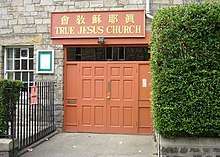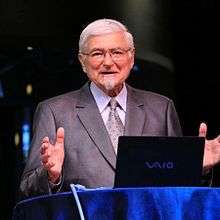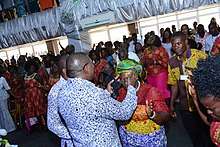Neo-charismatic movement
The Neo-charismatic (also third-wave charismatic or hypercharismatic) movement is a movement within evangelical Protestant Christianity that is composed of a diverse range of independent churches and organizations that emphasize the post-Biblical availability of gifts of the Holy Spirit, such as speaking in tongues and healing. The Neo-charismatic movement is considered to be the "third wave" of the Charismatic Christian tradition which began with Pentecostalism (the "first wave"), and was furthered by the Charismatic movement (the "second wave").[1] As a result of the growth of postdenominational and independent charismatic groups, Neo-charismatics are now believed to be more numerous than the first and second wave categories. [2] As of 2002, some 19,000 denominations or groups, with approximately 295 million individual adherents, were identified as Neo-charismatic.[2]
History

The "first wave" of Charismatic Christianity is Pentecostalism, which originated in 1901 in Kansas and later spread to Texas, Los Angeles, and then to other countries.[3] Pentecostals formed their own churches and organizations, but by the 1960s their emphasis on the outpouring of the Holy Spirit and signs and wonders began to influence mainline Protestant denominations and the "second wave," or the charismatic movement, began.[4] The Neo-charismatic movement, dubbed the "third wave", dates from the early 1980s and was a result of the growth of Pentecostal experiences among independent and indigenous Christian groups. Although the Neo-charismatic movement emerged in the 1980s, many churches in Africa were already exhibiting Neo-charismatic tendencies in the early twentieth century as some churches combined indigenous cosmologies with the gifts of the Holy Spirit.[4] The greatest concentration of Neo-charismatic churches is found in Africa, Asia, and Latin America.[5] In some regions, especially Africa and Latin America, Neo-charismatics are sometimes condemned by Pentecostals and Charismatics for their spiritual practices or for combining local cosmologies with Christian beliefs.[4]

Peter Wagner, who originally called this form of Christianity the "Third Wave" and is a theoretician of the Church Growth Movement, advocated for the principle of spiritual warfare against demons through his book Spiritual Power and Church Growth.[6][7] John Wimber, who founded the Association of Vineyard Churches in 1982, put forward the principle of "miraculous healing" as an element of the Christian life in his book Power Healing. The current of "power evangelism" was developed through the work of John Wimber and publicized through his book Power Evangelism.[8][9] Together, Wagner and Wimber taught a course on Neo-charismatic spiritual gifts called "Signs, Wonders, and Church Growth" at Fuller Theological Seminary for four years starting in 1982.[10] George Otis Junior is one of the originators of "spiritual mapping," which is a practice among some third wave adherents that includes uncovering the histories of buildings and geographical locations to understand how those histories might be contributing to demonic possession in the present.[11] In 2011, the movement (grouped with the charismatic movement), has 305 million people.[12]
Defining characteristics
In terms of congregational governance, no single form, structure, or style of church service characterizes all Neo-charismatic services and churches. The Neo-charismatic categorization is broad and diverse and includes any group that is not considered Pentecostal or Charismatic but still emphasizes the power of the Holy spirit and supernatural signs and wonders.[13] Pentecostals comprise Pentecostal denominations, charismatics bring Pentecostal tendencies to mainline denominations, but Neo-charismatics are indigenous, independent, post- and non-denominational Christian groups without formal denominational ties.[13] The term non-denominational is used more often by churches than the Neo-charismatic term.[14]

Members of the Neo-charismatic movement, like those in the Pentecostal movement and Charismatic movement, believe in and stress the post-Biblical availability of gifts of the Holy Spirit. These spiritual gifts, or charismata, frequently include but are not limited to glossolalia (speaking in tongues), healing, and prophecy. Additionally, Neo-charismatic Christians practice the laying on of hands and seek the "infilling" of the Holy Spirit, although a specific experience of baptism with the Holy Spirit may not be requisite for experiencing such gifts.[15][16] Neo-charismatic practices look very similar to Pentecostal and Charismatic practices, but the terminology used by Neo-charismatics to describe their practices is distinctly different from the typical terminology used by Pentecostals and Charismatics.[17] Many Neo-charismatics believe that the "end times" are near, practice intercessory prayer that invokes the power of the Holy Spirit, and view their work as helping to transform the Church into the Kingdom of God on earth.[18]
Similar to many Pentecostal and Charismatic groups, Neo-charismatics use electronic means of communication for broadcasting messages and worship services on social media, websites, radio stations, and television channels. Use of media resources enables Neo-charismatics to reach new audiences and grow their networks by reaching previously unreached people through technological means, and such communication has allowed for "democratized access to the Holy Spirit" because of the increasing forms of media that have been made available.[19]
Notable practices
Due to the diversity among churches and organizations that can be classified under the Neo-charismatic label, not all Neo-charismatics adhere to the following practices even if many of them do observe these sorts of rituals and beliefs.
Spiritual warfare
The fight against spiritual demons occupies an important place in Neo-charismatic teachings and prayers. The exorcising of demons is sometimes also referred to as deliverance ministries because a person or object is "delivered" or saved from an evil spiritual force.[20] Spiritual mapping, a subset of practices under the broad umbrella of spiritual warfare, is the process by which defiled land, houses, and churches are discovered through careful observation of the history of the region and are subsequently illustrated on a map. A relatively well-known example of this type of spiritual mapping occurred in Amarillo, Texas by the group Repent Amarillo.[21] If traumatic or evil histories are uncovered, mass exorcisms are sometimes organized to drive out territorial demons or historical demons in an ancestral line.[22] "Prayerwalking" is also an encouraged form of spiritual warfare among some Neo-charismatics and is connected to spiritual mapping. In prayerwalking, believers pray against evil spirits while walking through areas that are known as places where historical evil took place or are places where evil takes place currently.[23]
Power evangelism
The ability to bring about "signs and wonders" by Christians who have confessed their belief in the Holy Spirit and have been anointed to do miracles is an important aspect of Neo-charismatic evangelism. Healing and financial prosperity are examples of "power encounters," or supernatural acts, that occur in this type of evangelism.[24] Neo-charismatics believe power evangelism, in which supernatural wonders accompany the sharing of the Gospel message, is more effective than evangelism without signs and is more similar to the type of evangelism that first century Christians used.[25]
Structural renewal
Some Neo-charismatics are interested in the reconfiguration of church leadership to reflect a structure they believe is upheld in Ephesians 4:11-13, "The gifts he gave were that some would be apostles, some prophets, some evangelists, some pastors and teachers, to equip the saints for the work of ministry, for building up the body of Christ, until all of us come to the unity of the faith and of the knowledge of the Son of God, to maturity, to the measure of the full stature of Christ."[26] In this passage, there are five "offices," including apostle, prophet, evangelist, pastor and teacher. Pastors, teachers, and evangelists are commonly found in evangelical churches, but some Neo-charismatic groups and movements, like Five Fold Ministry and the New Apostolic Reformation, seek to restructure their church organization to actively include apostles and prophets.[27]
Notable churches
The following are examples of notable Neo-charismatic movements, associations, and congregations, along with their countries of origin:
- Association of Vineyard Churches (Vineyard Movement) — United States[28]
- Bethel Church — United States[29]
- Born Again Movement (or Word of Life Church) established by Peter Xu — China[30]
- Brazil for Christ (Brasil para Cristo) — Brazil[28]
- Catch the Fire Toronto (Partnered with Harvest International Ministries)[29]
- Christ Embassy[31]
- Calvary Chapel (United States)[28]
- God Is Love (Deus é Amor) — Brazil[28]
- Harvest International Ministries (HIM) — United States[29]
- International Christian Fellowship (Switzerland)[32]
- International House of Prayer (IHOP) — United States[29]
- Living Faith Church Worldwide[31]
- Newfrontiers[33]
- New Life Fellowship Association[34]
- Universal Church of the Kingdom of God (Igreja Universal do Reino de Deus) — Brazil[28]
- Wagner Leadership Institute — United States[29]
- Word of Faith[31]
References
- McCloud, Sean (2015). American Possessions: Fighting Demons in the Contemporary United States. New York: Oxford University Press. p. 6.
- Burgess, Stanley M; van der Maas, Eduard M, eds. (2002), "Neocharismatics", The New International Dictionary of Pentecostal and Charismatic Movements, Grand Rapids: Zondervan, pp. 286–87.
- Burgess, Stanley M., 1937- Van der Maas, Ed M. (2003). The new international dictionary of Pentecostal and charismatic movements. Zondervan Pub. House. pp. 14–15. ISBN 0-310-22481-0. OCLC 62596740.CS1 maint: multiple names: authors list (link)
- Burgess, Stanley M., 1937- Van der Maas, Ed M. (2003). The new international dictionary of Pentecostal and charismatic movements. Zondervan Pub. House. p. 15. ISBN 0-310-22481-0. OCLC 62596740.CS1 maint: multiple names: authors list (link)
- Burgess, Stanley M., 1937- Van der Maas, Ed M. (2003). The new international dictionary of Pentecostal and charismatic movements. Zondervan Pub. House. pp. 17–18. ISBN 0-310-22481-0. OCLC 62596740.CS1 maint: multiple names: authors list (link)
- Yannick Fer, La théologie du "combat spirituel": Globalisation autochtonie et politique en milieu pentecôtiste/charismatique, in J. Garcia-Ruiz et P. Michel (eds.), Néo-pentecôtismes, Labex Tepsis, pp. 52-64, 2016.
- Wagner, Peter C. Spiritual Power and Church Growth, Altamonte Springs, Fl. Strang Communications, USA, 1986. ISBN 0930525043
- Wimber, John (1986). Power Evangelism. San Francisco: Harper & Row Publishers. ISBN 0060695323.
- Pratt, Thomas D. (Spring 1991). "The Need to Dialogue: A Review of the Debate on the Controversy of Signs, Wonders, Miracles and Spiritual Warfare Raised in the Literature of the Third Wave Movement". Pneuma: The Journal of the Society for Pentecostal Studies. 13: 7–32. doi:10.1163/157007491X00024.
- Wagner, C. Peter (1988). The Third Wave of the Holy Spirit. Ann Arbor: MI: Vine Books. p. 24. ISBN 0892836016.
- McCloud, Sean (2015). American possessions : fighting demons in the contemporary United States. p. 51. ISBN 978-0-19-020538-6. OCLC 950475394.
- Pew Research Center, Global Christianity – A Report on the Size and Distribution of the World’s Christian Population, USA, December 19, 2011
- Burgess, Stanley M., 1937- Van der Maas, Ed M. (2003). The new international dictionary of Pentecostal and charismatic movements. Zondervan Pub. House. pp. 17–18. ISBN 0-310-22481-0. OCLC 62596740.CS1 maint: multiple names: authors list (link)
- Allan Anderson, An Introduction to Pentecostalism: Global Charismatic Christianity, Cambridge University Press, UK, 2013, p. 66
- Erwin Fahlbusch, Geoffrey William Bromiley, Jan Milic Lochman, John Mbiti, Jaroslav Pelikan, The Encyclodedia of Christianity, Wm. B. Eerdmans Publishing, USA, 2008, p. 445-446
- Young-hoon Lee, The Holy Spirit Movement in Korea: Its Historical and Theological Development, Wipf and Stock Publishers, USA, 2009, p. 4
- Burgess, Stanley M., 1937- Van der Maas, Ed M. (2003). The new international dictionary of Pentecostal and charismatic movements. Zondervan Pub. House. p. 14. ISBN 0-310-22481-0. OCLC 62596740.CS1 maint: multiple names: authors list (link)
- McAlister, Elizabeth. "Possessing the Land for Jesus." In Spirited Things: The Work of "Possession" in Afro-Atlantic Religions, edited by Paul Christopher Johnson, 177-205.Chicago, University of Chicago Press, 2014. p. 179. ISBN 022612276X
- Hüwelmeier, Gertrud. Krause, Kristine. (2011). Traveling spirits : migrants, markets and mobilities. Routledge. p. 85. ISBN 978-0-415-80800-2. OCLC 751750425.CS1 maint: multiple names: authors list (link)
- McCloud, Sean (2015). American possessions : fighting demons in the contemporary United States. p. 10. ISBN 978-0-19-020538-6. OCLC 950475394.
- McConeghy, David Walker. "Geographies of Prayer: Place and Religion in Modern America." PhD diss., University of California Santa Barbara, 2013, p.75.
- McCloud, Sean (2015). American possessions : fighting demons in the contemporary United States. pp. 58–59. ISBN 978-0-19-020538-6. OCLC 950475394.
- McConeghy, David Walker. "Geographies of Prayer: Place and Religion in Modern America." PhD diss., University of California Santa Barbara, 2013, p. 14.
- George Thomas Kurian, Mark A. Lamport, Encyclopedia of Christianity in the United States, Volume 5, Rowman & Littlefield, USA, 2016, p. 87
- Wimber, John (1986). Power Evangelism. San Francisco: Harper and Row, Publishers. pp. 34–35. ISBN 0060695323.
- Eph. 4:11-13, New Revised Standard Version Bible
- John Weaver, The New Apostolic Reformation: History of a Modern Charismatic Movement, McFarland & Company, USA, 2016, p. 87
- Sarah Hinlicky Wilson, A Guide to Pentecostal Movements for Lutherans (Wipf & Stock, 2016), p. 16.
- Brad Christerson & Richard W. Flory, The Rise of Network Christianity: How Independent Leaders are Changing the Religious Landscape (Oxford University Press, 2017), pp. 6 & 147.
- Robery Menzies, "Pentecostals in China" in Global Renewal Christianity: Asia and Oceania Spirit-Empowered Movements, Past, Present, and Future ()eds. Vinson Synan & Amos Yong: Charisma Media, 2016), p. 77.
- Resane, Kelebogile T. "Miracles in the Neo-charismatic movement: Historical and theological critique". Researchgate. AOSIS. p. 4. Retrieved 16 January 2020.
- Müller, Francis (2015). Selbsttransformation und charismatisch evangelikale Identität : Eine vergleichende ethnosemantische Lebenswelt-Analyse (in German). Springer VS. ISBN 978-3658092504.
- Hutt, Brian (4 October 2010). "Christians can't grow into maturity alone, says Virgo". Christianity Today. Retrieved 14 January 2020.
- Moberg, Jessica; Skjoldli, Jane (2019). Charismatic Christianity in Finland, Norway, and Sweden : case studies in historical and contemporary developments. algrave Macmillan. p. 187. ISBN 978-3319888132.